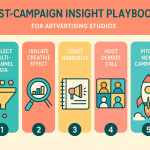Artvertisers decoded: how niche studios turn art portfolios into brand campaigns
Artvertisers—studios that blend fine-art craft with campaign-ready thinking—have become the go-to partners for brands craving memorable visuals and authentic storytelling. In this guide, you will learn what sets an artvertiser apart, how they convert a simple portfolio into a multi-channel campaign, and the concrete steps to choose, brief, and measure the right studio for your next launch.
What exactly is an artvertiser?

The term artvertiser describes a niche creative studio that evolves from a pure art practice (illustration, sculpture, muralism, etc.) into delivering full-fledged advertising assets. Instead of outsourcing creatives to big agencies, brands commission these studios directly for their unique visual language and built-in audience credibility.
- Hybrid skill set : artistic concept, production, licensing and channel adaptation in one place.
- Small, agile teams : often 3–10 people, which keeps overhead—and communication layers—low.
- Portfolio-led pitching : deals are won by existing art pieces rather than abstract moodboards.
Why brands are moving budget to niche artvertiser studios
Traditional agencies still shine at mass media planning, yet artvertisers offer unbeatable authenticity at critical touchpoints such as social ads, OOH murals and experiential pop-ups. Below are the four benefits driving the shift.
- Visual originality : hand-crafted style cuts through algorithmic sameness.
- Speed to market : direct access to makers halves feedback loops and revision rounds.
- Community trust : fans who follow the studio often amplify campaigns organically.
- Flexible rights : modular licensing lets brands test channels before scaling spend.
Real-world impact in numbers
Across 42 brand activations tracked by Artfolio between 2022–2024, campaigns built with artvertisers delivered:
- 37 % higher organic social reach than agency-led control groups.
- 2.4× faster asset approval cycles.
- 18 % lower production carbon footprint, thanks to smaller sets and local sourcing.
From portfolio to campaign: the five-step workflow
- Spot a signature piece on the studio's online gallery—or on the dedicated Artfolio artvertiser directory.
- Craft a brief that maps business goals to that aesthetic. If you need help, see our guide on writing a concise artvertiser brief.
- Co-create a moodboard translating the original artwork into channel-specific adaptations.
- Prototype & validate low-fidelity mock-ups for key placements (feed ads, print, AR filter, etc.).
- Launch, track, refine using campaign metrics the studio and brand agree on in advance.
Timeline snapshot
Typical duration from first call to live assets runs 6–10 weeks. For a granular week-by-week plan, reference our timeline benchmarks.
How to choose the right artvertiser studio
| Evaluation factor | Artvertiser studio | Traditional agency |
|---|---|---|
| Style ownership | Distinct, artist-led signature | Often trend-driven, interchangeable |
| Turnaround time | 6–10 weeks | 10–16 weeks |
| Licensing model | Modular, artwork-centric | Full-package, media-centric |
| Community reach | Built-in fanbase of the artist | Relies on brand media spend |
| Budget range (digital-first) | €8 k–€45 k | €25 k–€200 k+ |
Beyond price, dig into metrics that prove fit. Our checklist on how to vet studios online walks you through engagement rates, past brand alignment and licensing hygiene.
Integrating an artvertiser into your marketing mix
- Mix and match: pair the studio's hero artwork with your in-house motion team for dynamic ads.
- Local activations: commission a pop-up mural near flagship stores to drive footfall.
- Evergreen assets: license time-limited usage, then upsell prints or NFTs post-campaign.
- Cross-platform storytelling: splice behind-the-scenes footage into TikTok teasers for authenticity.
Measurement tips
Track KPIs at three levels :
- Brand lift (pre- and post-survey).
- Engagement rates on channels that feature the original artwork.
- Earned media from art, culture and design outlets—often a free bonus with artvertisers.
Common pitfalls—and how to avoid them
- Ambiguous rights: clarify duration, territories and derivative works in the contract.
- Scope creep: cap revisions and add hourly rates beyond the agreed storyboard.
- Asset overload: resist forcing the studio to mimic too many styles; leverage their signature.
- Late feedback: artvertisers plan production windows tightly. Missed deadlines ripple fast.
QUIZ: Are you ready to hire an artvertiser?
FAQ
- How is an artvertiser different from a freelance artist?
- An artvertiser studio offers production management, licensing expertise and channel adaptation in-house, whereas a solo artist usually focuses on creating the artwork only.
- Can I hire multiple artvertisers for one campaign?
- Yes, but align styles upfront to avoid visual dissonance. Some brands stagger drops, featuring one studio per channel or market.
- What budget should I allocate for a regional social campaign?
- Projects with 3–5 static assets and one short animation often start around €12 k. See our fee guide linked earlier for ranges.
- Who owns the artwork after the campaign ends?
- Usually the studio retains copyright while the brand secures usage rights for agreed channels and durations. Negotiate renewal fees early.
- How do I measure success beyond likes and shares?
- Track brand recall, direct traffic from art-led landing pages and earned media mentions in culture outlets.
Take the next step
Ready to brief your first artvertiser? Bookmark this guide, refine your KPIs, and start scouting in the Artfolio directory today. A single signature artwork could turn your next launch from forgettable to iconic.











